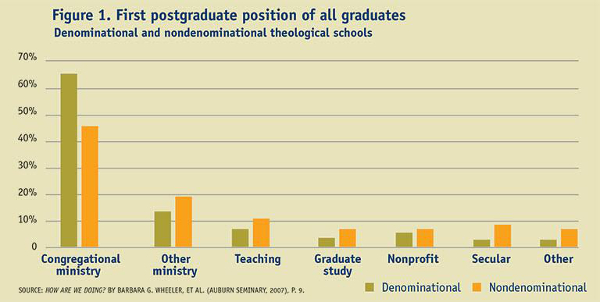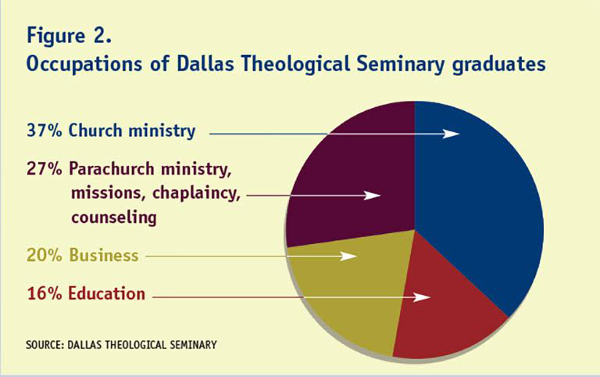For Tracy Ziebell, it was the day. Graduation arrived in all its pageantry, and she was celebrating. But she was worried too.
Tracy remembers standing amidst the revelry staring down at her diploma and thinking, “What next? Where am I going?” Like many in her graduating class from the Seattle School of Theology and Psychology, she was a nontraditional student. She was not planning to enter professional ministry, but she did want to take her theological education into a relevant field — something like counseling, nonprofit administration, or higher education. Unfortunately, she had no idea how to identify or even sort out other career options.
Tracy is not the only nontraditional graduate who has floundered in the job market. Some never find the opportunity to use their education. Earlier this year, Tracy told me, “At the time, I didn’t know what I was good at, what roles I could fill outside the church, or even how to go about finding work.” She meandered for two years before seeking career assistance and finally settling on a professional track.
Seminaries would do well to pay heed to Tracy’s predicament. Nontraditional students are a growing segment of theological school enrollment: The Association of Theological Schools (ATS) reports that theological schools graduated more non-M.Div. students in 2013 than in any year since they started counting in 1978. The master of divinity, or M.Div., is the typical degree for students entering professional ministry, while many students who pursue other career paths choose degrees other than the M.Div. The figures suggest that the number of students headed for non-ministry careers is rising.
 |
Figure 1, from a study by the Auburn Center for the Study of Theological Education, reinforces the trends suggested by the ATS data. And journalists have taken notice too: Michelle Boorstein, a religion editor with the Washington Post, writes that many seminarians are interested in taking their training and commitments into fields other than parish ministry. (See “Seminary Graduates Not Always Ministering from the Pulpits,” which is available at bit.ly/NotFromPulpit.)
At my institution, Iliff School of Theology, we find that 40 percent of our students are in nontraditional fields, and other seminaries are seeing similar figures. As Figure 2 shows, only a third of the graduates of Dallas Theological Seminary are in a traditional church ministry. Over all, according to the most recent responses to the Entering Student Questionnaire from ATS, more than 30 percent of new seminary students plan to enter secular or nonprofit jobs after graduation.
 |
While the supply of nontraditional seminary graduates increases, the demand for such graduates may be rising too. A recent report from Deloitte Consulting says that “the proportion of employers citing employee culture and engagement as a ‘very important’ issue” in hiring nearly doubled from 2014 to 2015, from 26 percent to 50 percent. The Deloitte study says that companies are increasingly trying to form a corporate culture marked by “meaningful work, deep employee engagement, job and organizational fit, and strong leadership.” (For more, see Global Human Capital Trends 2015 at bit.ly/GlobalHumanCapital2015).
These are skills in which many seminary graduates excel. Theologian Linda Cannell notes this in her article “Adaptive Leadership,” which appeared in Theological Education in 2011. “Leading people … involves fostering a climate in which people can talk about what is worthy, identify what the organization is in service to, and practice skills such as inquiry, accepting and working across difference, observing, diagnosing, and so on,” she writes. “Theological schools should be among the best in the world at these sorts of tasks.”
Unfortunately, many seminaries have not stayed current with the type of career services that are needed to help nontraditional graduates land suitable employment. While students in a conventional religious leadership track enjoy a fairly direct route towards employment, nontraditional graduates are often on their own. For theological schools, the challenge is to help nontraditional graduates step into the secular arena with appropriate guidance on how to show potential employers how their theological education can help them thrive in a nonministerial environment — and satisfy the demands of secular employers.
In my experience, nontraditional graduates are often stymied by two barriers in the job market:
-
First, many cannot readily answer this question: “Given your theological background, what skills do you have that can help us?” Nontraditional graduates must learn to spell out exactly how they can meet the needs of employers. They must clearly describe how they will make a valuable contribution to the team. Comprehensive career guidance can aid graduates as they learn to describe themselves in terms of achievements, demonstrated outcomes, and skills. For example, a graduate who is applying to be a development officer at a nonprofit can learn to demonstrate a successful legacy of generating donor support and to articulate how her abilities will benefit the organization.
-
Second, many don’t know how to uncover opportunities in the “hidden job market” — that mysterious realm of jobs that are not posted. Uncovering hidden jobs requires savvy and well-executed strategies, but this aspect of the job market bewilders many job seekers. Professional career services can help job seekers combine research and strategic networking to unearth job opportunities.
Some seminaries are trying to address these challenges. For example, at Claremont School of Theology, Associate Dean Lea Appleton says that their use of an outside career development service has significantly helped nontraditional students by focusing on ways that students can use their theological education in a variety of employment contexts.
If theological schools want to continue to draw and serve nontraditional students, they should attend to the career prospects of these students. This requires analyzing the results of the Entering Student Questionnaire and the Graduating Student Questionnaire, two ATS surveys that ask students directly about their career plans. It requires acknowledging and celebrating the fact that not all graduates are moving into full-time ministry. And it requires an investment of time and money to help these students learn how to move seamlessly into secular or nonprofit employment.
None of these activities is particularly easy, but they can turn a grim scenario into an upbeat one: Grateful graduates who infiltrate the work world with energy, optimism, and a vision to change the world for good.
Five steps to creating a career center
1. Plan. Lay out a comprehensive design for who will be served, what programs will be offered (and when), how students will access online resources, and how services will be delivered and coordinated.
2. Place. Designate a safe place for confidential, private consultation that is readily accessible to students. Locate it near high-traffic areas to raise visibility.
3. Programs. Offer training in writing resumes, CVs, and cover letters, and in the best use of social media, networking, and job research. Use multiple instructional formats.
4. Personnel. Select career consultants who have a background in theological studies and first-hand, successful experience in job hunting — in both the nonprofit and for-profit sectors.
5. Promotion. From the outset, promote the benefits of career services to all students, faculty, staff, and trustees. Create printed materials for orientation packets. Post career advice on the school’s website. Host “meet and greet” events where students and career center staff can meet in an informal setting.